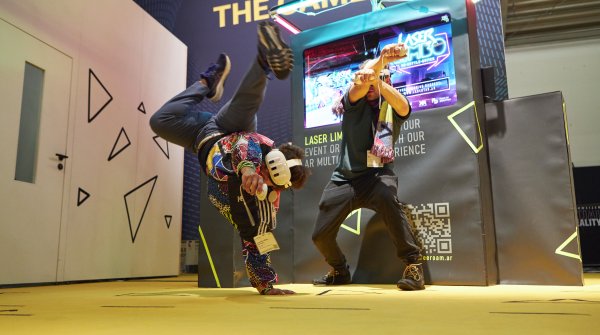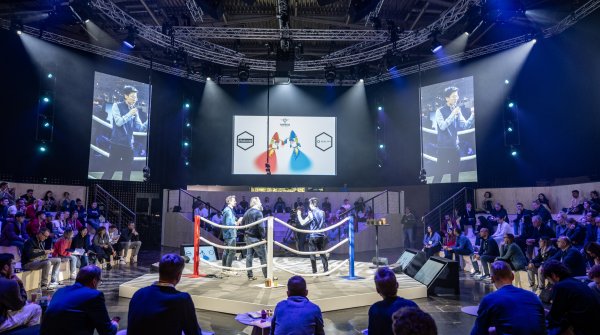Physical eSports means that physical sports are supplemented by digital technology. The "e" stands for electronic. The technology can be augmented reality (AR) or virtual reality (VR), as well as a sensor on the wrist that transmits movements. Often, the athlete is transferred to a virtual world as an avatar with a special input device.
Another option is to transmit body movements to a digital playing field via sensors. This makes training very playful. This approach is also known as gamification. The focus in eSports eSports often focus on measuring oneself against other participants, i.e. on competition.
A major contribution to physical eSports is the gamification approach. This is about integrating playful elements into the sport. This includes rewards, but also the progress bar, which you use to race towards your goal, or the opportunities to compete with other people.
Collecting virtual goods or experience points is also motivating, and ever new high scores and levels invite you to keep going. Because all of this pays off on the brain's reward system and stimulates the release of dopamine. Gamification leads to people being more motivated and also learning better.
The playful elements make you forget how strenuous the workout is. This increases your stamina as if by chance and the inner pig belongs to the past.
Physical eSports can be tried out by anyone. Of course, people with a digital affinity will probably find it easier to get excited about the possibilities. Anyone who already uses virtual reality applications for their computer games at home will have no reservations about putting on a headset or transmitting their movements to the computer via sensor, or even playing a sports competition as a video game themselves.
If the eSport is played as a computer game, knowledge of the computer game and the rule is of course a prerequisite to be successful. In addition, hand-eye coordination and reaction speed are crucial.
In addition, good spatial orientation, tactical skills, forward thinking and stamina contribute to success.
Physical eSports is multifaceted. There is no such thing as one application. Rather, more and more sports are being transferred to the digital world through virtual applications - a few examples at a glance.
A smart and stylish solution for physical eSports training at home is Vaha's digital fitness mirror. It is a man-sized touchscreen that can be used to access a wide range of fitness programs, including live and on-demand courses. The offerings range from cardio classes to yoga to downright boot camps.
You might remember dodgeball from school. In the AR game from the Japanese manufacturer Hado, you have to throw your opponents not with a softball, but with an electronic ball of light. The game is controlled via an iPod on the wrist and a headset on the head.
Beat Saber is about cutting small blocks with light sabers, in time to the music. The music and the playful approach make you forget pretty quickly how strenuous the whole thing actually is and how the whole body is challenged.
At Sense Dojo, a virtual coach creates a personal training and nutrition plan for you. You'll also be supported in buying fitness equipment that perfectly complements your training. In the background, an artificial intelligence analyzes your behavior and adapts everything individually to you.
Hyrox already offers sports enthusiasts a whole range of sports options. These include Physical eSports integration into CrossFit or Triathlon. This allows athletes to take their training to a whole new level. Participants can compete against each other in various races at conventions around the world.
Physical eSports has the potential to make its way into all areas of sports. It is just about any type of training possible. Recreational athletes can use eSports to increase their fitness in a fun way by cutting blocks of color with a lightsaber to music or doing cardio training cardio workout using gamification elements. A competitive athlete, on the other hand, can use eSports for targeted training.
Physical eSports are about real physical activity and training. eSportsmen, on the other hand, perform their sport within video games. eSportsmen who play at a professional level now earn a lot of money doing so.
There are own training centers and coaches, who supervise the athletes on a professional level. At the same time, eSports are linked to classic competitive sport comparable. Professional eSports players usually take part in tournaments or championships organized by game manufacturers or their own leagues. Even eSports betting has become a big trend.
There is no official umbrella organization. Therefore, mainly the game manufacturers take care of the technical infrastructure and the organization of the competitions. As a rule, hobby eSportsmen can also register or qualify for these tournaments. The tournaments with the most spectators so far included the Lol World Championship, the Fortnite World Cup Finals and the Free Fire World Series Rio. Even at the Olympic Games, eSports is now a discipline in its own right.
In some countries, such as South Korea, China, France, the USA or Brazil, eSports are recognized as a sport. The German Olympic Sports Confederation has so far spoken out against recognition.
But in general, there are also more and more sports clubs in Germany that are setting up eSports departments and investing in youth work in particular.
There is also, for example, the so-called Uni-Liga, in which amateur competitions are held for students.
In Asia, eSports are already much more widespread than in Europe or America. There, classic video games are highly popular as eSports variants. In Europe, experts assume that eSports will establish itself less in the video game sector and more as physical eSports in the fitness sector. This is because the gamification approach is an important factor here in promoting people's desire to exercise.
- Awards
- Mountain sports
- Bike
- Fitness
- Health
- ISPO Munich
- Running
- Brands
- Sustainability
- Olympia
- OutDoor
- Promotion
- Sports Business
- Textrends
- Triathlon
- Water sports
- Winter sports
- eSports
- SportsTech
- OutDoor by ISPO
- Heroes
- Transformation
- Sport Fashion
- Urban Culture
- Challenges of a CEO
- Trade fairs
- Sports
- Find the Balance
- Product reviews
- Newsletter Exclusive Area
- Magazine






